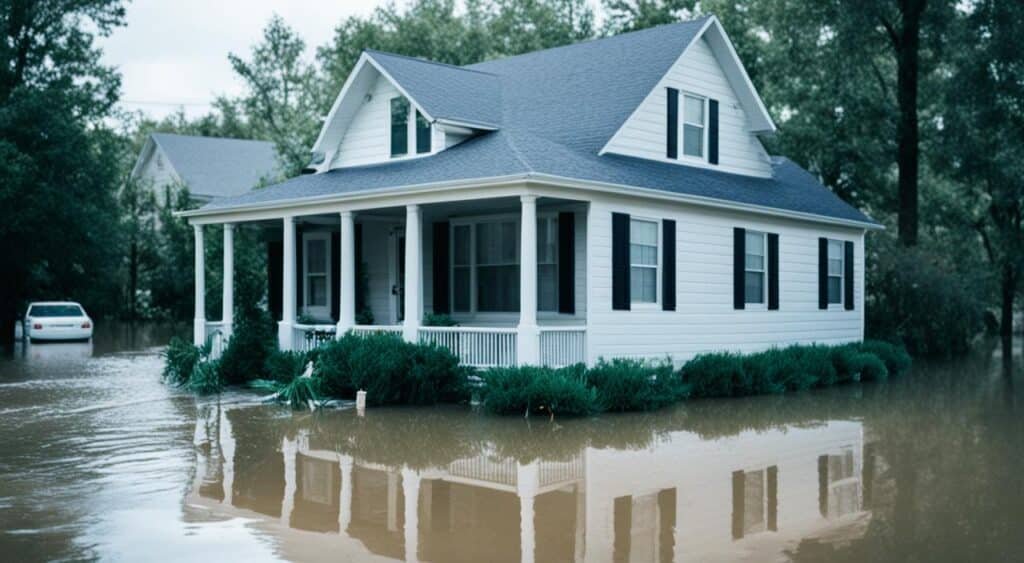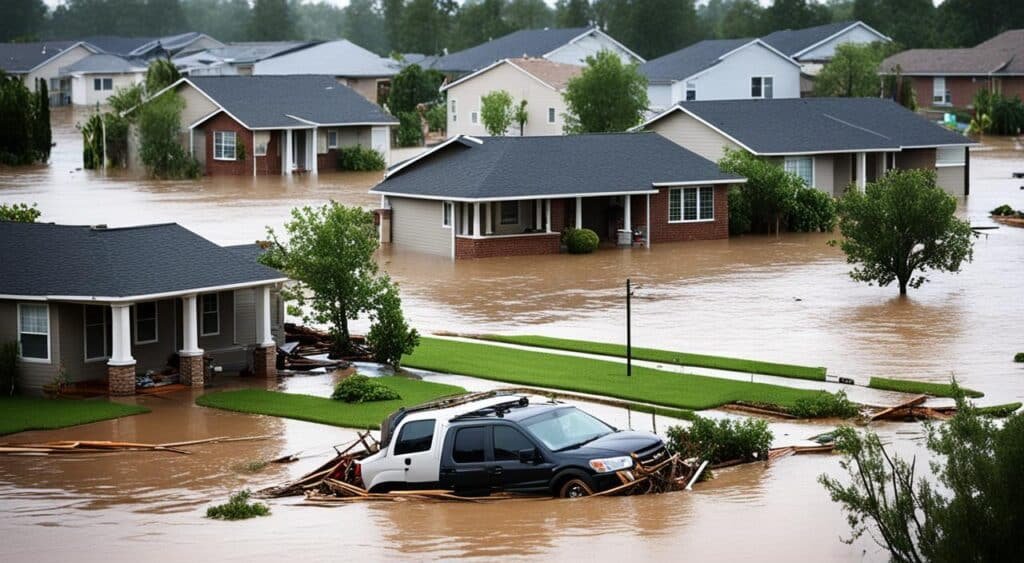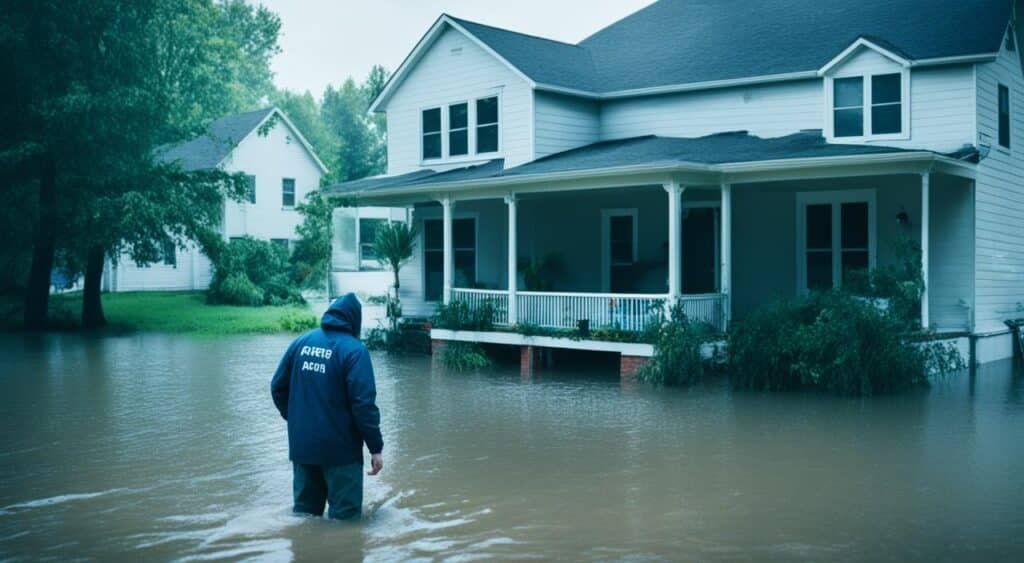Flooding is a major issue in the U.S., causing billions in damage yearly. Home insurance usually takes care of water damage from inside issues, like burst pipes. However, it doesn’t help if the water comes from outside sources like rain, rivers, or storm surges. Here, flood insurance steps in to protect your property.
This insurance, available through the National Flood Insurance Program (NFIP) or private companies, covers both your home’s structure and your belongings. It includes important stuff like electrical systems, appliances, and carpets. If you live in a flood-prone area with a mortgage from a federal program, you’ll need this extra coverage.
Key Takeaways
- Flood insurance provides coverage for the structure and contents of a home, including electrical and plumbing systems, furnaces, water heaters, appliances, carpeting, and personal belongings.
- Flood insurance is a separate policy from standard homeowners insurance and is required for properties in high-risk flood areas with federally backed mortgages.
- The National Flood Insurance Program (NFIP) is the primary provider of flood insurance in the United States.
- Flood insurance can help protect you from the financial devastation caused by flooding, which is one of the most common and costly natural disasters in the country.
- Understanding the coverage and limitations of flood insurance is crucial for homeowners to ensure their properties are adequately protected.
Understanding Flood Insurance
Flood insurance gives you protection against flood damages. It’s not usually part of regular homeowners’ insurance. You can get it from the National Flood Insurance Program (NFIP) and some private companies. This insurance is a must-have because floods can happen anywhere. Even one inch of water can cause up to $25,000 in damage.
What Flood Insurance Is and Why It Matters
This type of insurance helps keep your home and things safe from flood damage. Normally, your home insurance doesn’t cover floods. Flood insurance takes care of risks from water going up. This might happen because of heavy rain or big storms. Having flood insurance is important. It helps you get back on your feet after a flood. You won’t have to pay for all the repairs or new things by yourself.
Also Read: What Are The Benefits Of Having A Life Insurance Policy?
Differences Between Flood Insurance and Homeowners Insurance
- Flood insurance helps with damage from water levels going up, which home insurance usually doesn’t cover.
- NFIP and private companies offer flood insurance, but regular home insurance is from different companies.
- There are different coverage limits and deductibles for flood and home insurance.
- Flood insurance and home insurance have different rules for who can get them and how.
It’s important to know how flood insurance is different from home insurance. This knowledge helps make sure you’re fully covered in a flood. Having dedicated flood insurance helps protect your savings. It also helps you get through the tough times of flood damage faster.
“Floods can happen anywhere, even in low-risk areas, and just one inch of floodwater can cause up to $25,000 in damage.”
The National Flood Insurance Program (NFIP)

The National Flood Insurance Program (NFIP) plays a key role in flood protection in the U.S. It’s run by the Federal Emergency Management Agency (FEMA). The NFIP gives flood insurance to those in areas that follow floodplain rules.
The NFIP’s main goal is to lessen flood damage by offering affordable insurance. It also pushes for better floodplain management in communities. Over 50 insurance companies work with the NFIP to offer coverage nationwide.
Another big plus of the NFIP is how it improves floodplain management. Communities in the program must take steps to lessen flood harm. This includes making better building regulations and adding better infrastructure. This team effort helps save lives and protect property from floods.
The NFIP is also vital in aiding those hit by floods financially. It offers help to both homeowners and businesses, making recovery faster. This is especially crucial for communities with fewer resources.
Also Read: The Role Of Technology In University Campus Safety
In summary, the National Flood Insurance Program is essential for the country’s flood plan. It brings together the government, insurance firms, and local areas. They work towards a solid flood readiness and recovery strategy.
Flood Insurance Coverage

Flood insurance from the NFIP has two main parts: one covers the building, the other the contents. They protect your home’s structure and what’s inside. This protection is key if a flood happens.
Building Coverage
Building coverage takes care of your home’s core parts: the electrical, plumbing, and more. It makes sure your home stays standing after a flood.
Also Read: What Types Of Athletic Programs Do Universities Offer?
Contents Coverage
Contents coverage is for what’s inside your home, like furniture and clothing. It also covers valuable things like artwork up to $2,500. This helps you replace your belongings after a flood.
| Coverage Type | What It Protects |
|---|---|
| Building Coverage |
|
| Contents Coverage |
|
With strong flood insurance from NFIP, both your home and its contents are safer from flood damage. Knowing about the building and contents cover helps protect what matters most.
“Flood insurance is an essential safeguard for homeowners, providing peace of mind and financial security in the face of unpredictable natural disasters.”
What Flood Insurance Doesn’t Cover

Flood insurance covers a lot, but there are things it doesn’t. It’s important to know what’s not included. This helps make sure you’re fully protected.
Not being able to live in your home is a big deal. Flood insurance doesn’t pay for a place to stay or your meals if you have to leave. Those costs are up to you to cover.
It’s good to understand what your outdoor space isn’t covered. Things like gardens and pools are not part of the deal. They’re seen as separate from the main house.
Running a business that gets flooded is a tough hit. This insurance won’t pay for the money you lose. It’s a risk you should know about.
Also Read: What Is Risk Management In The Context Of Insurance?
Some valuables aren’t under flood insurance’s umbrella. Think cash, fancy metals, or your car. Those need their own protection.
Basements often miss out on coverage for their stuff. Your basement’s stuff, like a fridge or couch, might not be insured.
| Exclusion | Description |
|---|---|
| Temporary Housing and Living Expenses | Costs associated with temporary shelter and meals during a flood event are not covered. |
| Property Outside the Insured Building | Landscaping, decks, swimming pools, and other outdoor features are not included in coverage. |
| Business Interruption | Financial losses due to disruption of business operations are not covered. |
| Precious Metals, Currency, and Vehicles | These items are typically excluded from flood insurance policies. |
| Personal Property in Basements | Contents of basements, such as appliances and furniture, are often not covered. |
Knowing what’s not covered is just as crucial as what is. It lets you plan better and find other ways to keep your things safe. This is key for recovering after a flood.
Purchasing Flood Insurance
Flood insurance is available to those in around 23,000 areas under the National Flood Insurance Program (NFIP). If you live in a high-flood-risk zone and have a federally backed mortgage, you must get flood insurance.
Eligibility and Requirements
To buy flood insurance, contact your insurer or check the NFIP’s options. A new NFIP policy usually takes 30 days to start, unless your lender needs it or the flood maps in your area are changing.
Also Read: What Are The Benefits Of Having Medical Insurance?
Different factors affect who can get flood insurance and what it covers:
- Location: Flood insurance is available to individuals and businesses located in NFIP-participating communities.
- Mortgage Status: Homeowners and businesses with federally backed mortgages in high-risk flood areas are required to have flood insurance.
- Flood Risk: The level of flood risk in a given area can impact the availability and cost of flood insurance coverage.
- Community Participation: The community’s participation in the NFIP program is a crucial factor in determining eligibility and requirements for flood insurance.
Make sure you understand what you need for flood insurance. It’s important for protecting your home and possessions.
| Flood Insurance Requirement | Explanation |
|---|---|
| Federally Backed Mortgage | Homeowners and businesses with a federally backed mortgage in a high-risk flood area are required to have flood insurance. |
| NFIP Community Participation | Flood insurance is only available in the nearly 23,000 communities that participate in the National Flood Insurance Program (NFIP). |
| Waiting Period | There is typically a 30-day waiting period before a new NFIP policy goes into effect, unless it is required by a lender or related to a community flood map change. |
Buying flood insurance is vital for your property and savings, especially in flood-prone areas. Do it to stay financially safe if flooding happens.
High-Risk Flood Areas

Flood insurance is important for homes and businesses in high-risk areas. These are called Special Flood Hazard Areas (SFHAs). The government labels them so because they’re likely to flood. This could be because they’re close to water or are flat.
If you have a federally backed mortgage, you need flood insurance if your place is in an SFHA. By law, lenders can’t give you a loan without flood insurance. So, if your home or business is in an SFHA, you have to get flood insurance.
Knowing if your property is in a high-risk flood area is key. FEMA has maps showing these SFHAs. They help lenders decide if flood insurance is a must for a property. So, owners in these zones must act. They need to buy flood insurance to meet rules and protect what they own.
| Criteria | Explanation |
|---|---|
| Special Flood Hazard Area (SFHA) | Areas labeled by FEMA as risky for flooding, often due to their location near water or low ground. |
| Federally Backed Mortgage | These are loans supported by agencies like the FHA. They help people who serve in the military, among others. |
| Mandatory Flood Insurance Requirement | No loan from a lender is possible without flood insurance if your place is in an SFHA. |
Understanding flood insurance and its rules is vital. This is for property owners, lenders, and those making policies. Knowing the facts and taking steps can help us all deal better with flood risks.
Waiting Period and Effective Date
Understanding the waiting period for flood insurance is key. The National Flood Insurance Program (NFIP) often has a 30-day wait time. This is unless special cases allow for coverage to start sooner.
The 30-day wait is in place to stop people from buying insurance last minute. It secures the program’s reliability. Yet, there are exclusions to this wait time rule:
- If flood insurance is mandated by a federally backed lender.
- In case of flood insurance associated with a community map change to a high-risk flood zone.
For both homeowners and lenders, grasping the waiting period and effective date is crucial. Knowing this helps them prepare. It makes sure they have coverage when needed.
| Scenario | Waiting Period | Effective Date |
|---|---|---|
| New NFIP flood insurance policy | 30 days | 31st day after purchase |
| Flood insurance mandated by a federally backed lender | No waiting period | Immediate |
| Flood insurance related to a community map change | No waiting period | Immediate |
Learning about the waiting period and effective date of flood insurance is important. It lets homeowners and lenders make smart choices. They can be sure they’re safeguarded from floods’ financial risks.
Flood Insurance Policies and Pricing
The National Flood Insurance Program (NFIP) provides a variety of insurance options. These are for both homeowners and business owners. Some options are the Dwelling, General Property, and Residential Condominium Building Association policies. They aim to give detailed flood insurance coverage.
The cost of these policies changes based on several things. This includes where the property is, the risk of flooding, and the building’s age and style. The Federal Emergency Management Agency (FEMA) manages the NFIP. It ensures that the pricing of these policies is fair and clear.
| Policy Type | Coverage Limits | Average Annual Premium* |
|---|---|---|
| Dwelling | Up to $250,000 for building, $100,000 for contents | $700 – $1,200 |
| General Property | Up to $500,000 for building, $500,000 for contents | $1,000 – $2,000 |
| Residential Condominium Building Association | Up to $250,000 per unit for building, $100,000 for contents | $800 – $1,500 |
*The estimated average premiums can change depending on the property and risk factors.
To choose the best flood insurance policy, it’s essential to know your options. This helps homeowners and business owners make smart choices. They can get the right coverage for fighting flood damages. By exploring what the NFIP offers, people can balance coverage limits and premiums wisely.
Working with the NFIP

The National Flood Insurance Program (NFIP) works together with many groups. It includes the government, insurance companies, states, and property owners. This teamwork makes sure everyone is covered when it comes to flood insurance.
Over 50 insurance companies are part of the NFIP’s Write-Your-Own program. They sell NFIP policies through their agents. This makes it easier for people to buy flood insurance.
The NFIP helps with more than just insurance. They offer tools like books, videos, and online materials. These resources explain how flood insurance works.
For NFIP policyholders, this help is great for understanding their coverage and filing claims. Insurance agents can also use these tools to help their clients better.
“The NFIP, with partners like FEMA and insurance companies, provides a full flood insurance package. It supports policyholders in their time of need.”
Working with the NFIP means property owners and sellers get important info. They learn about their flood insurance, keeping them safe from flood money worries.
| NFIP Resources | Description |
|---|---|
| Publications | Brochures, guides, and manuals teach you all about flood insurance. This includes what your policy covers, how to make a claim, and how to recover. |
| Videos | Watch videos that explain how to buy flood insurance, claim processes, and navigate the NFIP. They give clear steps. |
| Online Tools | Online calculators help you figure your flood risk, the amount of coverage you need, and what your policy offers. |
With the NFIP’s help and its network, property owners, agents, and servicers can handle flood insurance better. They manage claims well and help with the recovery after a flood.
Flood Preparedness and Mitigation

Flood preparedness and mitigation are key to the National Flood Insurance Program (NFIP). Cities and towns in the program must have rules to handle floods. These rules help reduce the harm floods cause. They also keep new buildings safe from floods. Homeowners and businesses can add to this safety. They can check their own flood risk and find ways to lower it. This helps keep their buildings safe from flood damage.
Community Floodplain Management Regulations
Part of the NFIP is making communities create floodplain rules. These rules are about how to build or change buildings in the flood area. By following these rules, towns lessen the chances of flood damage. They make sure new buildings are strong enough to deal with floods.
Flood Risk Assessment and Mitigation Strategies
Knowing your flood risk is the first step in staying safe from floods. Homeowners and businesses should talk to local experts. They can help understand the flood risk and suggest how to lower it. Suggested ways to reduce flood damage include:
- Elevating the structure above the base flood elevation
- Installing backflow valves to prevent sewage backups
- Securing valuable items and documents in waterproof containers
- Developing an emergency evacuation plan
By working to understand flood risk and taking steps to lower it, we can protect our homes. This reduces the chances of serious flood damage.
“Flood preparedness and mitigation mean more than just protecting our places. They are about keeping our communities alive and our lives safe.”
Also Read: What Are The Benefits Of Term Life Insurance And How Are Premiums Calculated?
Conclusion
Flood insurance is crucial for homes and businesses. It protects against serious flood damage. By knowing what the National Flood Insurance Program (NFIP) offers, people can make sure their places are safe. They need to know who can get it and what to do to lower risks.
Getting flood insurance means recovering faster after a flood hits. With the NFIP’s help and plans, owners can protect their properties and reduce flood costs. This insurance is important for anyone in flood-prone areas or facing harsh weather. Owners can prepare and not worry about starting over after a flood.
FAQs
Q: What is flood insurance and why is it important?
A: Flood insurance is a type of insurance coverage that specifically protects against property loss due to flooding. It is important because most standard home insurance policies do not cover flood damage, so having separate flood insurance can provide financial protection in the event of a flood.
Q: How much does flood insurance cost?
A: The cost of flood insurance can vary depending on factors such as the location of the property, the design of the building, the amount of coverage needed, and the flood risk zone. It is recommended to get quotes from different insurance providers to find the best rates.
Q: How do I know if I live in a flood zone?
A: You can find out if your property is located in a designated flood zone by checking flood maps provided by FEMA. These maps show areas at high risk of flooding and can help determine the need for flood insurance.
Q: What does flood insurance typically cover?
A: Flood insurance policies usually cover damage to the structure of the building, as well as contents such as furniture and appliances. However, it’s important to review the policy details as coverage can vary depending on the provider and policy type.
Q: Is flood insurance mandatory for homeowners?
A: In most cases, flood insurance is not mandatory for homeowners unless their property is located in a designated high-risk flood zone and they have a mortgage from a federally regulated or insured lender.
Q: What is the NFIP and how does it work?
A: The National Flood Insurance Program (NFIP) is a federal program administered by FEMA that offers flood insurance to property owners, renters, and businesses. The NFIP’s pricing approach considers factors such as the location of the property and the type of building, with different rates for single-family homes under NFIP’s pricing approach.
Q: How can I get flood insurance?
A: You can purchase flood insurance through insurance agents who are authorized to sell policies under the NFIP. You can also visit the flood insurance section on FEMA’s website or the Flood Map Service Center to learn more about getting a flood policy.
Source Links
- https://www.floodsmart.gov/whats-covered
- https://www.fema.gov/flood-insurance
- https://www.helpwithmybank.gov/help-topics/mortgages-home-equity/flood-insurance/flood-insurance.html





